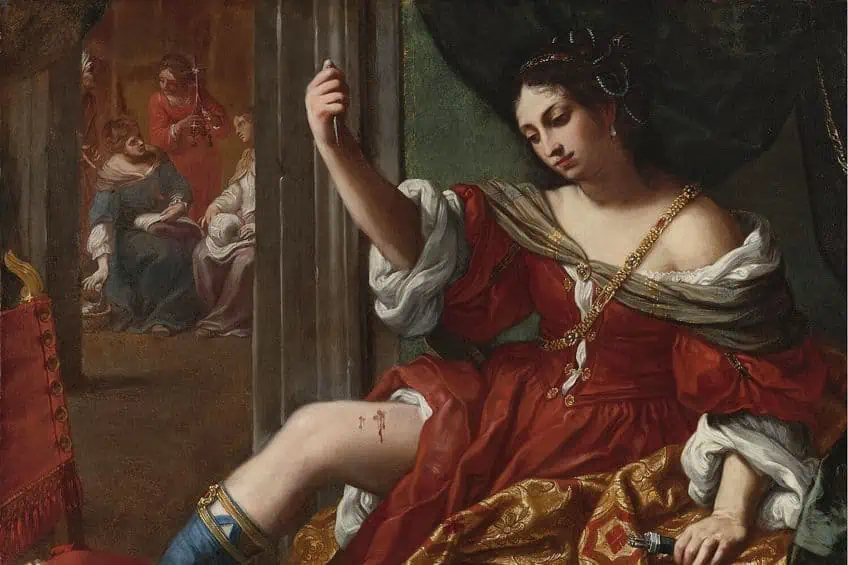Famous Renaissance Paintings – Explore This Influential Art Era
Over a period of 300 years, lasting from the 14th to the 17th century, artists of the era produced the famous Renaissance paintings that are still highly revered today. Art from the Renaissance era marked a return to the classical philosophies of the Romans and Greeks. These famous Renaissance artworks represented a massive advancement in techniques and materials, with the realistic representation of anatomy and linear perspective being two of the major developments. Today, we will learn more about the Renaissance artists’ paintings that embodied the era and forever changed the way art was produced.
Contents
- 1 Revealing the Most Famous Renaissance Paintings
- 1.1 The Betrayal of Christ (1306) by Giotto di Bondone
- 1.2 Holy Trinity (1428) by Masaccio
- 1.3 The Coronation of the Virgin (1432) by Fra Angelico
- 1.4 The Flagellation of Christ (1470) by Piero della Francesca
- 1.5 St. Jerome in His Study (1474) by Antonello da Messina
- 1.6 The Baptism of Christ (1475) by Andrea del Verrocchio
- 1.7 Lamentation of Christ (1480) by Andrea Mantegna
- 1.8 Delivery of the Keys (1482) by Pietro Perugino
- 1.9 The Birth of Venus (1486) by Sandro Botticelli
- 1.10 The Last Supper (1498) by Leonardo da Vinci
- 1.11 Sistine Madonna (1512) by Raphael
- 1.12 Bacchus and Ariadne (1523) by Titian
- 1.13 The Ambassadors (1533) by Hans Holbein the Younger
- 1.14 The Last Judgment (1541) by Michelangelo
- 1.15 Self-Portrait (1548) Catharina van Hemessen
- 1.16 Self-Portrait (1554) by Sofonisba Anguissola
- 1.17 Portrait of a Noblewoman (1580) by Lavinia Fontana
- 1.18 The Burial of the Count of Orgaz (1586) by El Greco
- 1.19 Portrait of Paolo Morigia (1595) by Fede Galizia
- 1.20 Portia Wounding Her Thigh (1664) by Elisabetta Sirani
- 2 Frequently Asked Questions
Revealing the Most Famous Renaissance Paintings
During the Renaissance era, many painters emerged that would subsequently be regarded as among the most significant artists in the history of art. Many of these artists were also involved in other spheres of academia such as philosophy, science, and the humanities. Let’s find out more about these multi-talented Renaissance artists’ paintings below.
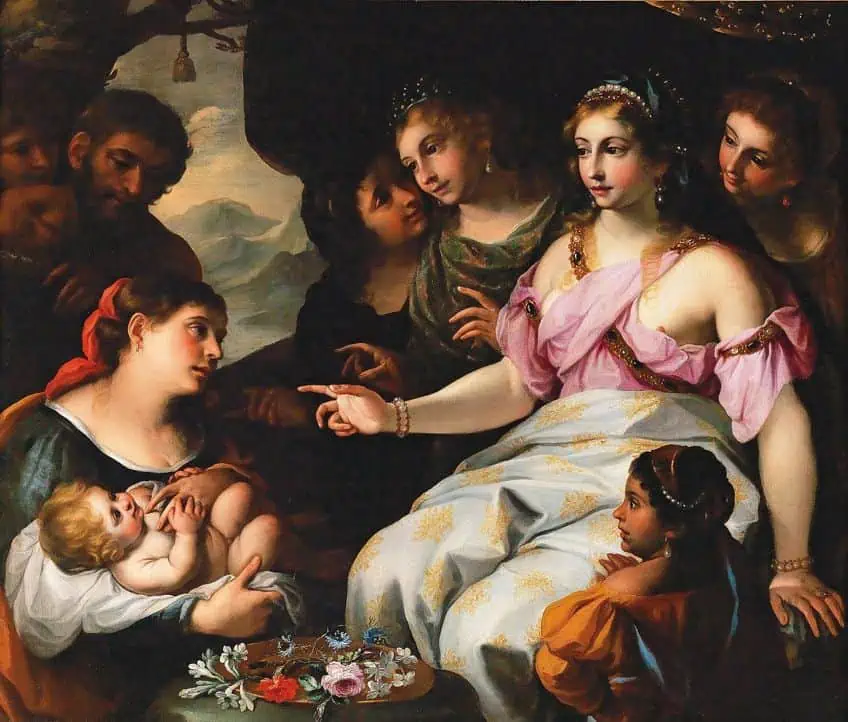
The Betrayal of Christ (1306) by Giotto di Bondone
| Artist Name | Giotto di Bondone (1267 – 1337) |
| Date Completed | 1306 |
| Medium | Fresco |
| Dimensions (cm) | 200 x 185 |
| Location | Scrovegni Chapel, Padua, Italy |
Giotto became a national hero after adapting the art of painting from the Greek style to Latin. He was the proponent of a completely new painting style, devoid of Hellenism and Byzantine art, and reminding people of Ancient Rome’s incredible past. This painting is often regarded as one of the best Scrovegni Chapel frescoes, the artworks that were produced inside the private chapel of the Scrovegni family.
This artwork depicts the moment when Christ was betrayed by Judas. The yellow cloak that Judas is wearing is believed to symbolize cowardice.
The artwork is arguably most known for putting an end to the classic medieval painting style and ushering in a new era of artistic innovation known as the early Renaissance. Giotto’s frescoes were regarded to be the most modern artworks created by any painter in that era. Giotto skillfully conveys the intensity and chaos of Christ’s arrest, and he also depicts the disparity in expressions between Judas and Christ as they confront each other.

Holy Trinity (1428) by Masaccio
| Artist Name | Masaccio (1401 – 1428) |
| Date Completed | 1428 |
| Medium | Fresco |
| Dimensions (cm) | 667 x 317 |
| Location | Santa Maria Novella, Florence, Italy |
Masaccio was a renowned artist from Florence who rose to prominence at the start of the 15th century. When he received entry into the Florence Guild of Painters in 1422, he met Brunelleschi and Donatello and was inspired by their art.
Although it may not be a painting that usually comes to mind when thinking about famous Renaissance artworks, this fresco at the Basilica of Santa Maria Novella was an important historical piece at the time of its creation.
This painting is said to be the first recorded example of a one-point linear perspective and was Masaccio’s final major commission before his passing. It portrays the crucifixion and the holy trinity, and what is most remarkable is the realistic depiction of the body of Jesus on the cross, seemingly weighed down by gravity. Saint John and Mother Mary are the two identifiable people in the artwork. The other two people are apparently representations of the men who commissioned the work.

The Coronation of the Virgin (1432) by Fra Angelico
| Artist Name | Fra Angelico (1395 – 1455) |
| Date Completed | 1432 |
| Medium | Tempera on panel |
| Dimensions (cm) | 112 x 114 |
| Location | Uffizi Gallery, Florence, Italy |
Despite his prominence, Fra Angelico is one of the most elusive figures in art. The man and artist lived so fully under his monk garb, burying himself within the rigors of life as a monk, that much of his early life, upbringing, and personality are all speculation. It is a renowned religious artwork that represents the Virgin Mary being crowned as heaven’s queen.
The artwork was most likely commissioned for the church of Sant’Egidio by a group of nuns.
The artwork has a spiritual and mystical quality prevalent in other works of the artist, which is enhanced by a vast assembly of angels, saints, and blessed beings. The piece’s use of vibrant colors and overall structure demonstrate the influence of Angelico’s mentor, Lorenzo Monaco. This beautiful work can now be seen at the Uffizi Gallery in Florence, Italy.

The Flagellation of Christ (1470) by Piero della Francesca
| Artist Name | Piero della Francesca (1415 – 1492) |
| Date Completed | 1470 |
| Medium | Tempera and oil paint |
| Dimensions (cm) | 58 x 81 |
| Location | Palazzo Ducale di Urbino, Urbino, Italy |
Piero della Francesca was born into an affluent merchant family and is regarded as one of the Renaissance’s most influential painters. This artwork is cited as another early example of linear perspective in art from the Renaissance period.
In the foreground of the painting are three individuals who may symbolize the past, present, and future, while in the background we can see Jesus being flagellated by a Roman soldier while Pontius Pilate looks on.
The entire image is unusual in that Christ is depicted as a little figure in the background, whereas the three bigger figures standing in the foreground appear significantly more notable. Despite the artwork’s brutal subject matter, it exudes calm and serenity. The individuals are rendered clinically sharp, and the architecture is delineated precisely; the setting is lit by a cold, clear light.
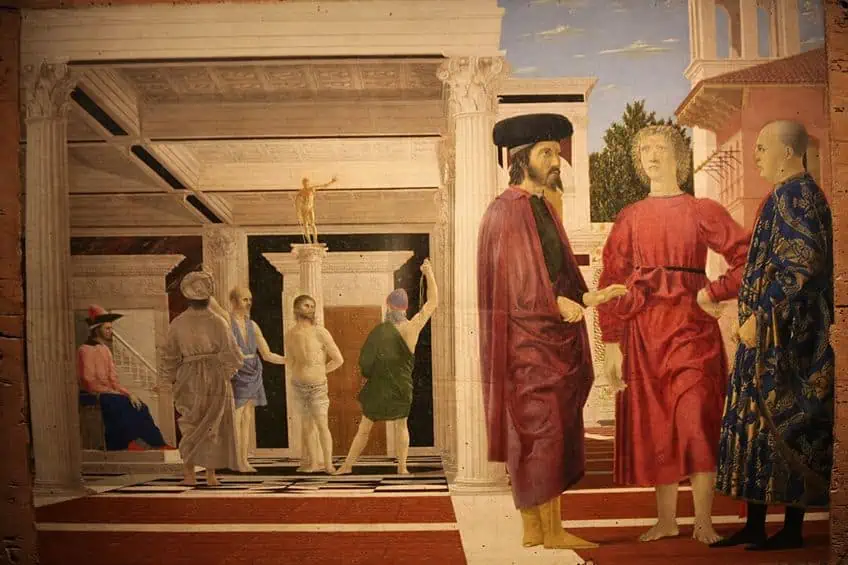
St. Jerome in His Study (1474) by Antonello da Messina
| Artist Name | Antonello da Messina (1430 – 1479) |
| Date Completed | 1474 |
| Medium | Oil on limewood |
| Dimensions (cm) | 45 x 36 |
| Location | National Gallery, London, United Kingdom |
The picture portrays human, natural, and heavenly knowledge, as well as architectural elements. It depicts St. Jerome, famous for his thoughts on Christian moral conduct, seated in his study, a space with no walls and a roof visible through an opening.
The light rays in the scene are aligned with the perspective axis, focused on the saint’s body and hands.
The artwork was discovered in the collection of Antonio Pasqualino in 1529. It was not positively assigned to Antonello da Messina until 1856. The painting’s many angles and intricacies indicate that it was most likely a demonstration piece for Venetian patrons. This piece, a combination of perspective and light, was most likely sent to Venice as a “painting essay” in order to draw future orders.
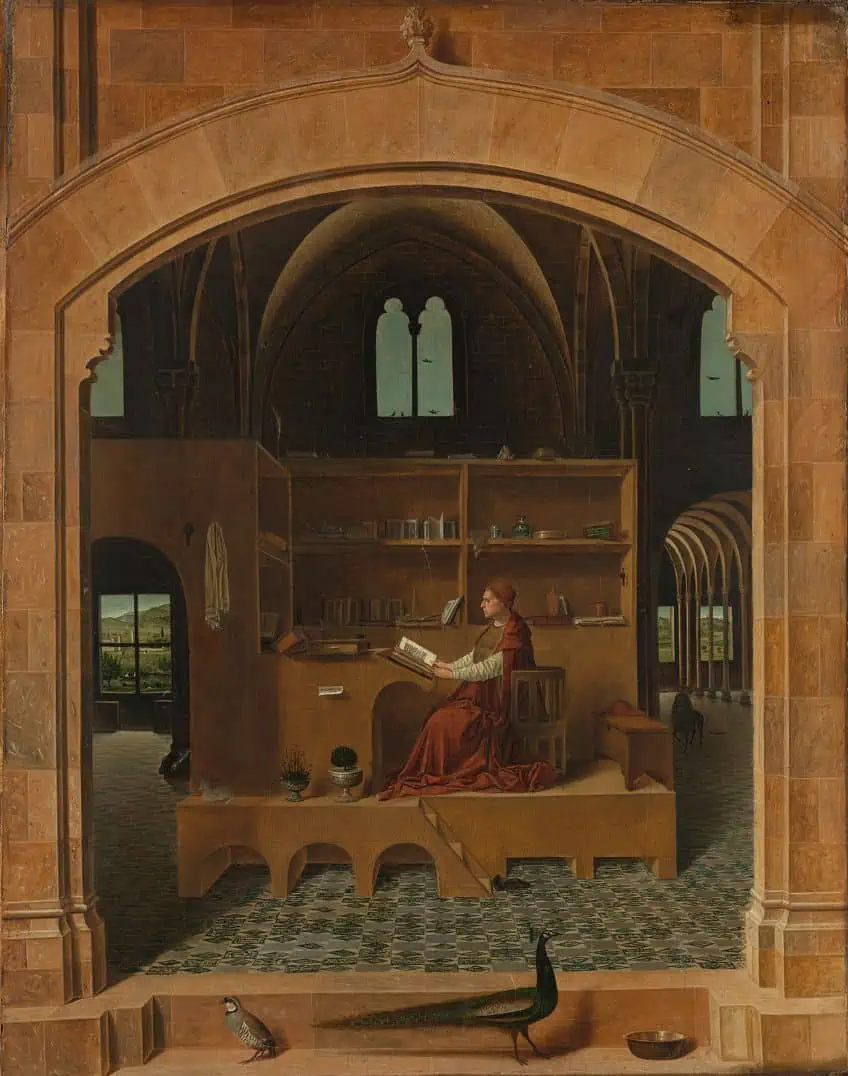
The Baptism of Christ (1475) by Andrea del Verrocchio
| Artist Name | Andrea del Verrocchio (1435 – 1488) |
| Date Completed | 1475 |
| Medium | Oil on canvas |
| Dimensions (cm) | 177 x 151 |
| Location | Uffizi Gallery, Florence, Italy |
This famous artwork was produced by Da Vinci’s mentor, Andrea del Verrocchio. This Renaissance artist’s paintings and sculptures had a huge impact on the world of art. He ran his workshop with the help of apprentices who went on to become famous painters, such as the aforementioned Da Vinci.
In fact, Da Vinci is believed to have helped Verrocchio finish this altarpiece.
It portrays John the Baptist in the act of baptizing Jesus. While Verrocchio was known to be a very influential painter, this is actually the only painting that has been attributed to the artist without any question as to its creator. The artwork was commissioned by the San Salvi Church’s monks in Florence, where it stayed until around 1530. It was then moved to Santa Verdiana, another monastery in Florence, in 1730, and then in 1810, it was moved once again to the Florentine Galleries. Today, it is part of the Uffizi Gallery’s incredible collection.
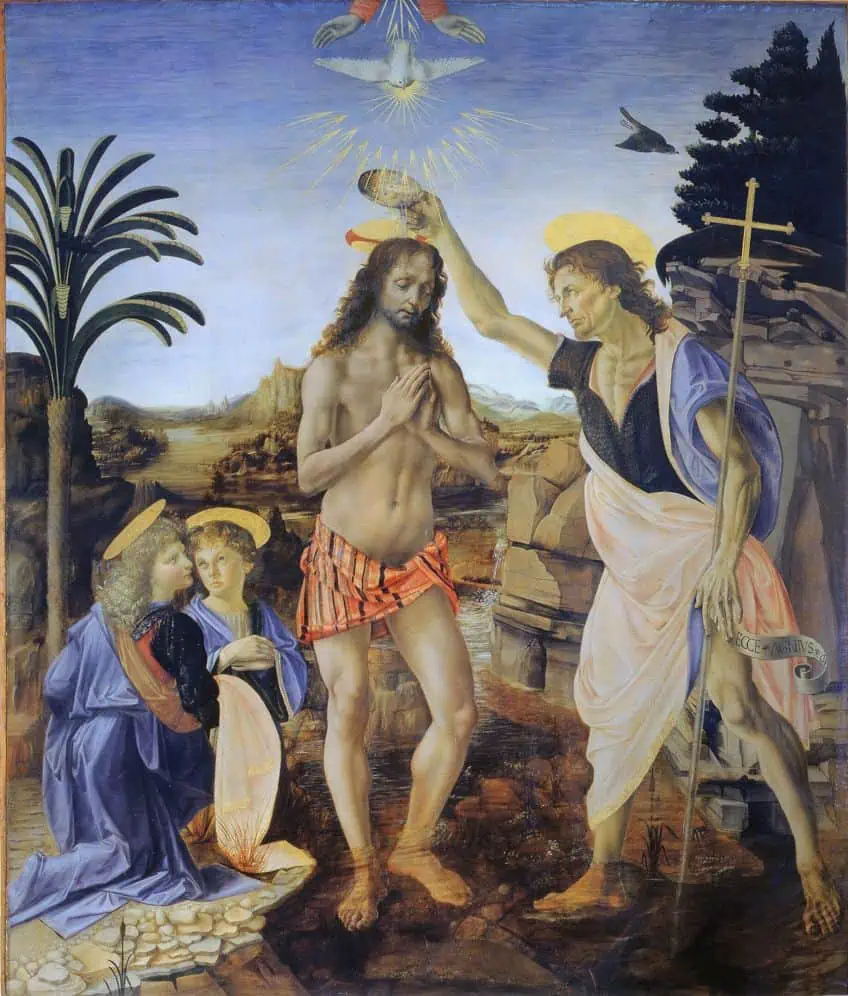
Lamentation of Christ (1480) by Andrea Mantegna
| Artist Name | Andrea Mantegna (1431 – 1506) |
| Date Completed | 1480 |
| Medium | Tempera on canvas |
| Dimensions (cm) | 68 x 91 |
| Location | Pinacoteca di Brera, Milan, Italy |
Mantegna’s art from the Renaissance period is recognized for its linear clarity and meticulous attention to detail. He is especially renowned among Italian Renaissance artists for his unwavering devotion to ancient antiquity. In this artwork, Mantegna produced a fascinating study of a severely foreshortened corpse as well as an immensely moving portrayal of a tragic biblical event.
He wanted the perspective to create the feeling that the audience could just reach out and touch Christ.
One symbolic interpretation of presenting a person from the feet first in perspective is that the person in question has lost a battle of some sort. This is often used to represent people who have been denied holy protection. Mantegna, on the other hand, depicts the most holy person in such a pose in this painting. Christ’s head is turned away from those present in the painting and is facing the direction of the light.

Delivery of the Keys (1482) by Pietro Perugino
| Artist Name | Pietro Perugino (1446 – 1523) |
| Date Completed | 1482 |
| Medium | Fresco |
| Dimensions (cm) | 335 x 550 |
| Location | Sistine Chapel, Vatican City |
Pietro Perugino is regarded as a significant Italian Renaissance artist renowned for his volatile temper and absence of belief in religion. His artworks, such as Delivery of the Keys, illustrates his ability to effectively convey clarity of form and perspectival space. Raphael, his most renowned pupil, absorbed certain features of Perugino’s artworks but eventually surpassed them.
This renowned artwork portrays an event in which Christ, wrapped in a blue-colored cloak, appears in front of a classical structure designed to look like the Temple of Solomon.
The painting’s composition is highly structured, with the subjects positioned symmetrically. Perspective is also used effectively, as the landscape and architecture appear to fade into the background. The main message of this artwork is the authority that Christ bestowed upon Saint Peter. It symbolizes the Catholic Church’s conviction in its divine duty to shepherd and guide its flock.

The Birth of Venus (1486) by Sandro Botticelli
| Artist Name | Sandro Botticelli (1445 – 1510) |
| Date Completed | 1486 |
| Medium | Tempera on canvas |
| Dimensions (cm) | 172 x 278 |
| Location | Uffizi Gallery, Florence, Italy |
Sandro Botticelli, the renowned Renaissance artist from Florence, was one of Italy’s most celebrated painters of his time. Botticelli was at his most creative from 1478 to 1490, and it was at this time that he painted his famous Renaissance paintings with mythological themes, such as The Birth of Venus.
The arrival of the nude goddess Venus rising from the shell floating on the Cyprus coast is the focal point of this incredible mythological artwork.
It represents the revival of civilization, the cultural transformation that happened following the instability of the Middle Ages. Many interpretations of the artwork have been given by scholars, the most prevalent being that the artist sought to convey the Neoplatonic notion of divine love in his representation of Venus. The artwork is said to have been commissioned for the walls of the bedroom of a Medici family member. It remains one of the most recognizable and famous Renaissance artworks ever created.

The Last Supper (1498) by Leonardo da Vinci
| Artist Name | Leonardo da Vinci (1452 – 1519) |
| Date Completed | 1498 |
| Medium | Fresco |
| Dimensions (cm) | 460 x 880 |
| Location | Santa Maria delle Grazie, Milan, Italy |
Leonardo da Vinci was an Italian Renaissance scientist, artist, and inventor who is often regarded as one of the most gifted and creative individuals of all time. Although there aren’t too many of his paintings left now, he is perhaps most known for these artworks and earned a significant reputation during his lifetime as a result of them.
The Last Supper is among his most renowned works, and maybe one of the most famous in the world.
Da Vinci had never worked on such a huge painting before, and he had no prior experience with the traditional fresco medium. The artwork was created using experimental colors painted straight on to the dry plaster wall, and unlike other famous frescoes, where the pigments are blended with the wet plaster, it hasn’t held up well over time. Yet, it still remains one of the most famous Renaissance paintings ever.
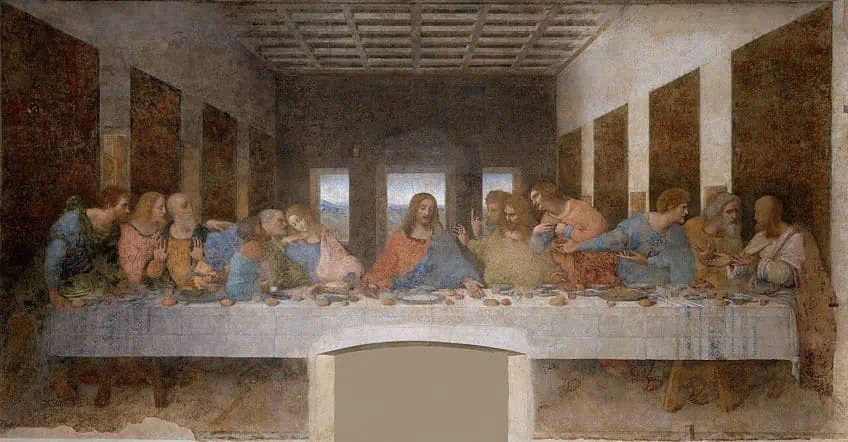
Sistine Madonna (1512) by Raphael
| Artist Name | Raphael (1483 – 1520) |
| Date Completed | 1512 |
| Medium | Oil on canvas |
| Dimensions (cm) | 265 x 196 |
| Location | Gemäldegalerie Alte Meister, Dresden, Germany |
Despite having died at the young age of 37, Raphael was regarded as among the most prolific and talented artists of the High Renaissance period. He worked all around Italy, particularly Florence, before being invited to Rome by Pope Julius II at the age of 25.
This artwork was originally commissioned by the Pope for the chapel of San Sisto in Piacenza before being relocated to Dresden in 1754.
It represents the Virgin Mary cradling the newborn Jesus, with Saint Barbara and Saint Sixtus flanking her on either side, while cherubs look up at Mary in the foreground. It is believed that these cherubs were modeled on two children who would often come in to watch him paint. It is regarded as among the most renowned Renaissance artworks of the Virgin Mary and was a master lesson regarding the use of lighting and shadows from Raphael.

Bacchus and Ariadne (1523) by Titian
| Artist Name | Titian (1490 – 1576) |
| Date Completed | 1523 |
| Medium | Oil on canvas |
| Dimensions (cm) | 175 x 190 |
| Location | National Gallery, London, United Kingdom |
This renowned Renaissance painting was produced by Titian, often regarded as among the finest Venetian painters. He produced portraits, as well as works with mythological and religious themes, and worked for popes and royalty during his illustrious career. It was commissioned by the Duke of Ferrara who wanted a series of mythological paintings for his personal quarters.
Raphael was originally asked to produce the artwork, but only a preliminary sketch had been drawn by the time of the artist’s death in 1520.
The theme of the artwork is based on a story by Ovid. In the painting, the mythological figure of Bacchus is portrayed leaping out of his chariot in order to defend Ariadne from the beasts. Bacchus then lifted her to the heavens and transformed her into a constellation, which is depicted by the stars that can be seen above Ariadne’s head. It is considered by many people to be the artist’s best work and is currently displayed at the National Gallery in London.

The Ambassadors (1533) by Hans Holbein the Younger
| Artist Name | Hans Holbein the Younger (1497 – 1543) |
| Date Completed | 1533 |
| Medium | Oil on oak |
| Dimensions (cm) | 207 x 209 |
| Location | National Gallery, London, United Kingdom |
Holbein was a talented 16th-century portraitist, often regarded as one of the best of the period. He liked to travel and is documented as having visited northern Italy, Lucerne, and France. During these years, he created fresco designs, woodcuts, and panel paintings.
Despite being a German-born painter who lived in England for a considerable amount of time, this particular painting illustrates an Early Netherlandish influence.
The person on the right is dressed like a member of the clergy, whereas the person on the left is dressed in a more secular style. In addition to the double portrait, the artwork includes a still life of precisely portrayed objects, the significance of which has been much debated. Many believe the artwork portrays the strife between clergy and scholars. The distorted skull, depicted in anamorphic perspective, is the most renowned of the artist’s symbols in the piece. It can only be viewed properly from a specific angle.
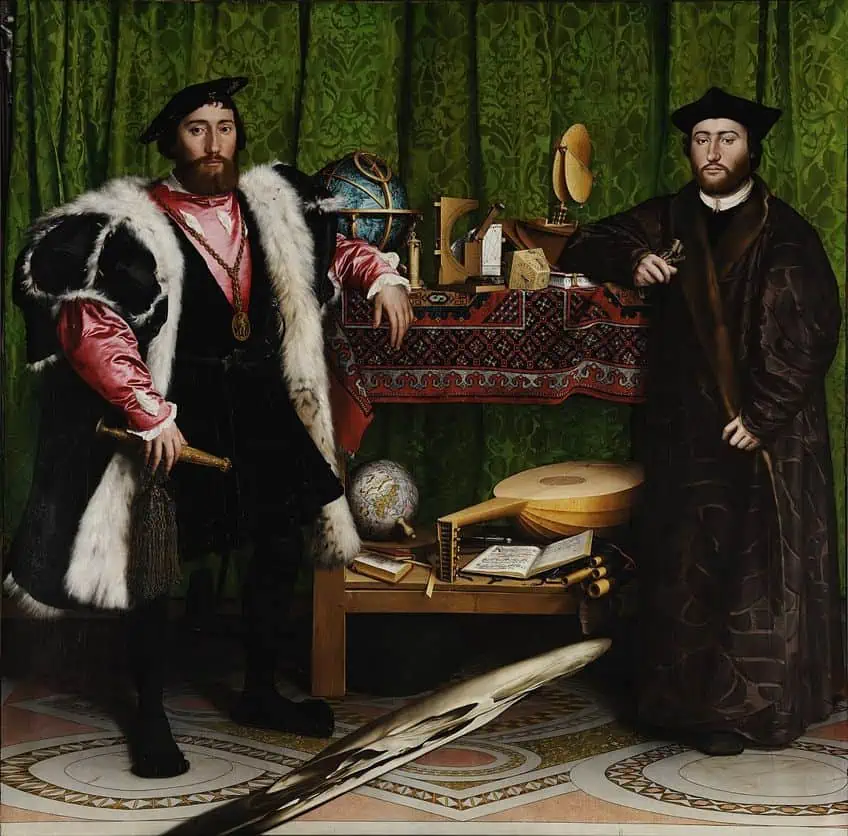
The Last Judgment (1541) by Michelangelo
| Artist Name | Michelangelo (1475 – 1564) |
| Date Completed | 1541 |
| Medium | Fresco |
| Dimensions (cm) | 137 x 120 |
| Location | Sistine Chapel, Vatican City |
The famous artist Michelangelo was a painter, sculptor, and architect widely regarded as one of the Renaissance’s greatest artists. His art displayed an unprecedented combination of psychological comprehension, intensity, and realism. The Last Judgment (1541) is arguably one the most renowned of the Renaissance artist’s paintings.
It took four years to complete and was produced 25 years after he completed the ceiling of the Sistine Chapel.
Michelangelo followed the artistic tradition in depicting those who were saved ascending to the left of the canvas and the condemned falling to the right in the bottom section of the painting. The people of Heaven are joined in the upper part of the canvas by the recently saved individuals. The Last Judgment was a popular subject for big church frescos, but it was rare to have it above the altar when its traditional location was over the doors at the back of a building. It was usually placed at the back so that people would be reminded of the choices they make as they exit the church.

Self-Portrait (1548) Catharina van Hemessen
| Artist Name | Catharina van Hemessen (1528 – 1565) |
| Date Completed | 1548 |
| Medium | Oil on oak |
| Dimensions (cm) | 30 x 24 |
| Location | Kunstmuseum Basel, Basel, Switzerland |
Catharina van Hemessen was a well-known Flemish artist who worked during the Renaissance era. Despite the fact that she was born at a period when women were not permitted to participate in any kind of art, she managed to break with the cultural norms of the time and established herself as an acclaimed artist.
This self-portrait is said to be one of the first to depict an artist portrayed with their tools of the trade.
She portrayed herself dressed in a black brocade gown with crimson velvet sleeves. While such an ensemble would be impracticable for a painter working with pigments and paintbrushes, her garments are intended to demonstrate her social standing and to convey dignity. Some have questioned the work’s provenance, and some have hypothesized that it was produced by Jan Sanders van Hemessen, her father.

Self-Portrait (1554) by Sofonisba Anguissola
| Artist Name | Sofonisba Anguissola (1532 – 1625) |
| Date Completed | 1554 |
| Medium | Oil on panel |
| Dimensions (cm) | 19 x 12 |
| Location | Kunsthistorisches Museum, Vienna, Austria |
Sofonisba Anguissola, a late Italian Renaissance artist most renowned for her portraits, was among the first female artists to be recognized around the world. She produced at least 12 self-portraits during an era when this was not a popular subject matter for painters. Anguissola depicts herself painting in this self-portrait from 1556.
She is portrayed adding pigments to a canvas depicting the Virgin Mary and Jesus as a baby.
She is wearing a simple black dress, presumably to represent modesty and purity. Displaying oneself in the act of painting connected her to a long heritage of artists who depicted themselves, not all of whom were males. While there were other artists who created self-portraits at the time, those that incorporated the painter’s tools, such as the palette and canvas, were less prevalent. However, from the 16th century onwards, painters portraying themselves with their tools grew in popularity.
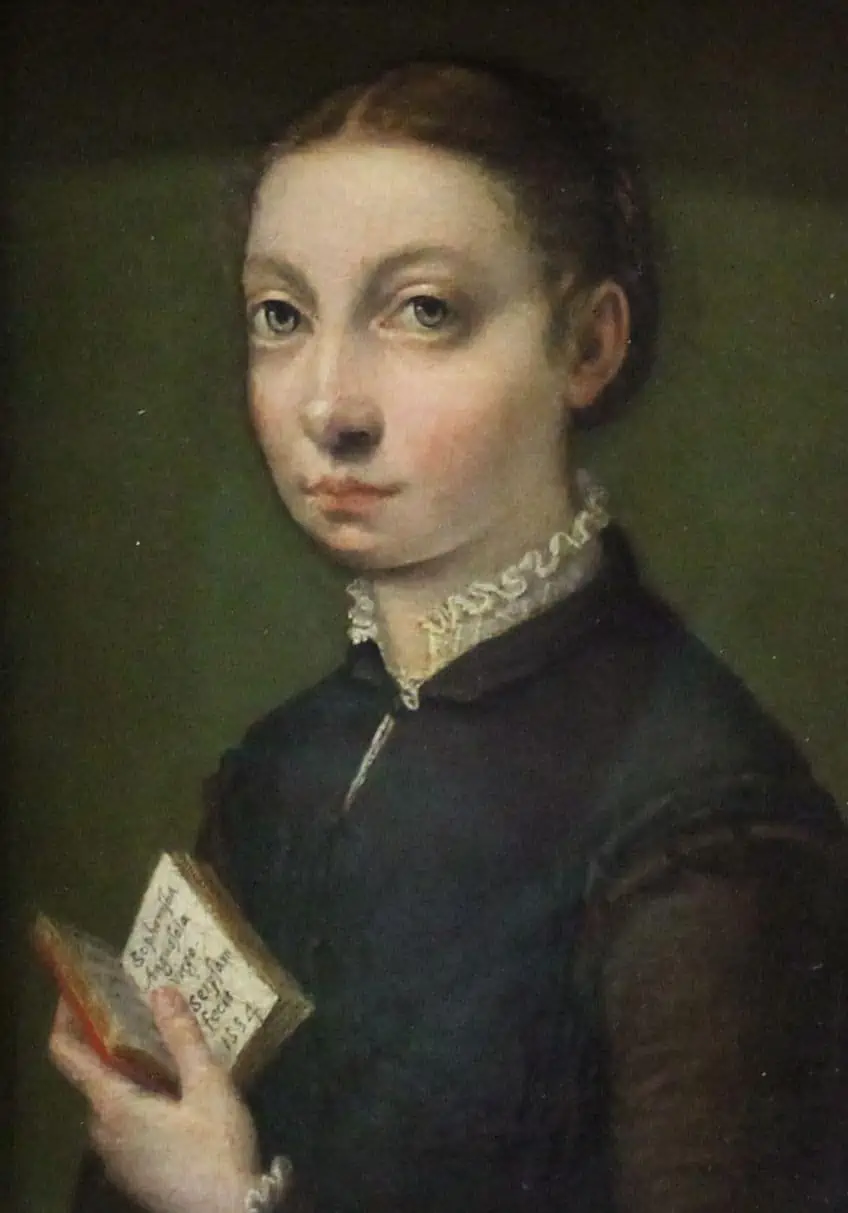
Portrait of a Noblewoman (1580) by Lavinia Fontana
| Artist Name | Lavinia Fontana (1552 – 1614) |
| Date Completed | 1580 |
| Medium | Oil on canvas |
| Dimensions (cm) | 115 x 90 |
| Location | National Museum of Women in the Arts, Washington D.C., United States |
Lavinia Fontana, often considered the first female artist, was also the first female to portray women in the nude. She was very popular in the area of portraiture and rose to fame both inside and outside of Italy. This piece exemplifies Lavinia Fontana’s ability to depict luxurious garments and jewelry in exquisite detail.
The juxtaposition between the female subject and the plain background is particularly evident, directing viewers’ attention to the subject portrayed.
According to modern research, scholars believe that this portrait of an unknown young noblewoman is likely her wedding portrait. According to research into family diaries and books from this time period, the clothing and jewels represented here fit with the objects typically associated with a wealthy bride’s trousseau. A strange object hanging from the woman’s waist is referred to in several family records from this period. It is a pelt lavishly decorated with various jewels and serves as another indication of the bride’s prosperity.

The Burial of the Count of Orgaz (1586) by El Greco
| Artist Name | El Greco (1541 – 1614) |
| Date Completed | 1586 |
| Medium | Oil on canvas |
| Dimensions (cm) | 480 x 360 |
| Location | Iglesia de Santo Tomé, Toledo, Spain |
Few Old Masters produced pieces as strikingly fresh to modern eyes as El Greco. This artwork, which was commissioned for the Santo Tomé church in Toledo is considered one of El Greco’s best. Saint Augustine and Saint Stephen, according to legend, descended from heaven to personally lay the Count of Orgaz to rest.
They may be seen in the front, gleaming in golden gowns.
Behind these individuals, a line of somber-looking witnesses separates Christ’s heavenly realm from the ceremony’s earthly location, indicating the spiritual salvation awaiting the devoted. The person in the back row of the gathering of Toledo nobility peering out of the artwork is apparently meant to be the artist himself. The artist’s son is also said to be depicted and can be seen standing to the bottom left, holding a torch.
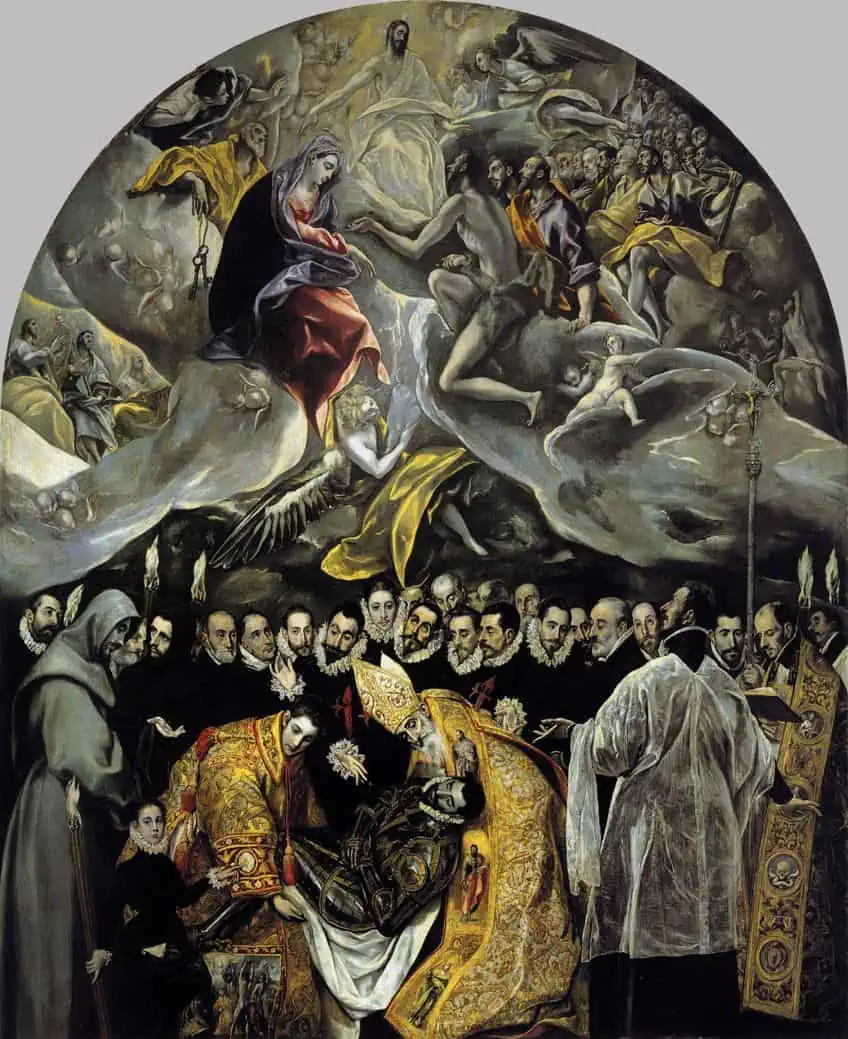
Portrait of Paolo Morigia (1595) by Fede Galizia
| Artist Name | Fede Galizia (1578 – 1630) |
| Date Completed | 1595 |
| Medium | Oil on canvas |
| Dimensions (cm) | 88 x 79 |
| Location | Pinacoteca Ambrosiana, Milan, Italy |
The female Italian Renaissance artist Fede Galizia specialized in portraits, still lifes, and religious works. Her painting technique was influenced by the naturalistic traditions of the Italian Renaissance, resulting in a highly realistic approach.
Her painting abilities are very apparent in her painting of the General of the Jesuati, Paolo Morigia, who was among her first supporters and patrons.
He is portrayed holding a pair of spectacles with his left hand and writing the lyrics for a musical piece with his other hand. The reflections of windows in the lenses of the glasses reveal the impact of the Flemish art from that era. The expressiveness of the lips is inspired by the realism of Giovanni Battista Moroni and the physiognomical examinations that were prevalent in Lombardy at the time because of Leonardo da Vinci.
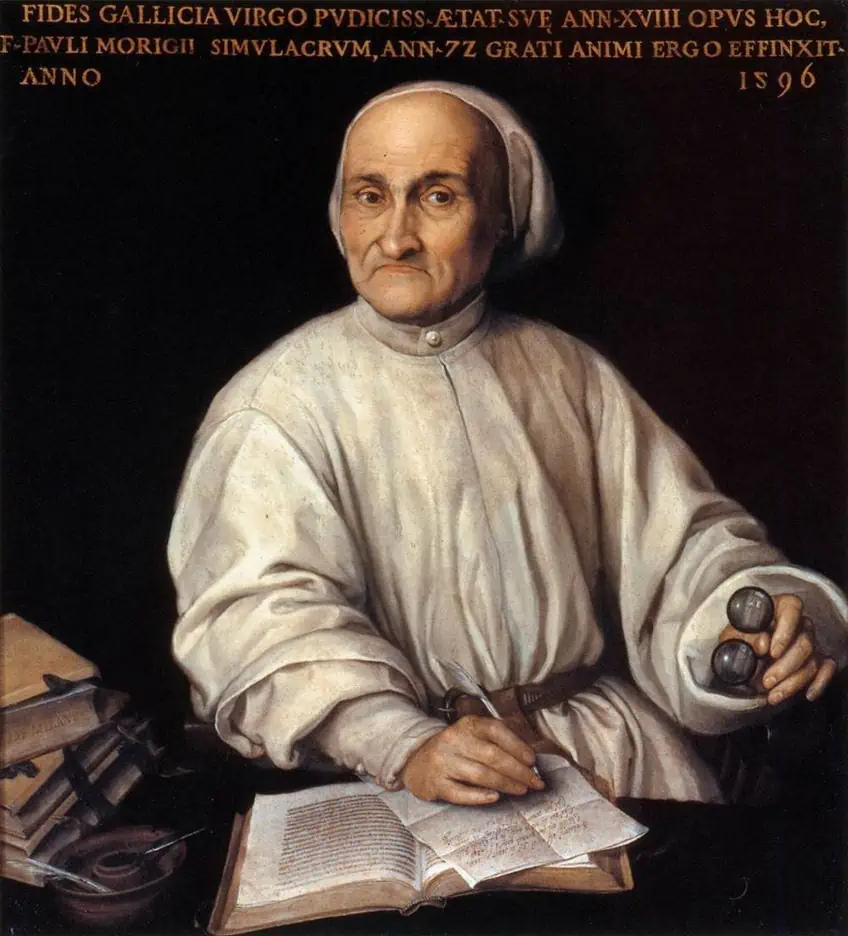
Portia Wounding Her Thigh (1664) by Elisabetta Sirani
| Artist Name | Elisabetta Sirani (1638–1665) |
| Date Completed | 1664 |
| Medium | Oil on canvas |
| Dimensions (cm) | 101 x 138 |
| Location | Private collection |
Sirani was born into an artistic family and studied at her father’s workshop, as was common for female artists at the time. However, her style was quite different from her father’s, and it connected to more recent advancements in Bolognese art. This painting portrays a woman holding a knife, and her thigh is bloodied with stab wounds beneath the blade. If one observes her expression and pose, one can see that she is intentionally inflicting these wounds on herself in a very calculated manner. This is a portrayal of Portia Catonis, a real-life Roman historical figure. She was a member of the Roman nobility as well as a passionate pupil of philosophy. She gained prominence as the wife of Julius Caesar’s most renowned assassin, Brutus. She once saw her husband contemplating an assassination, but he refused to tell her about it as he was afraid that she would possibly reveal his plans if someone tortured her. So she slashed her thigh, suffering silently for a day to prove that she was able to endure physical pain.
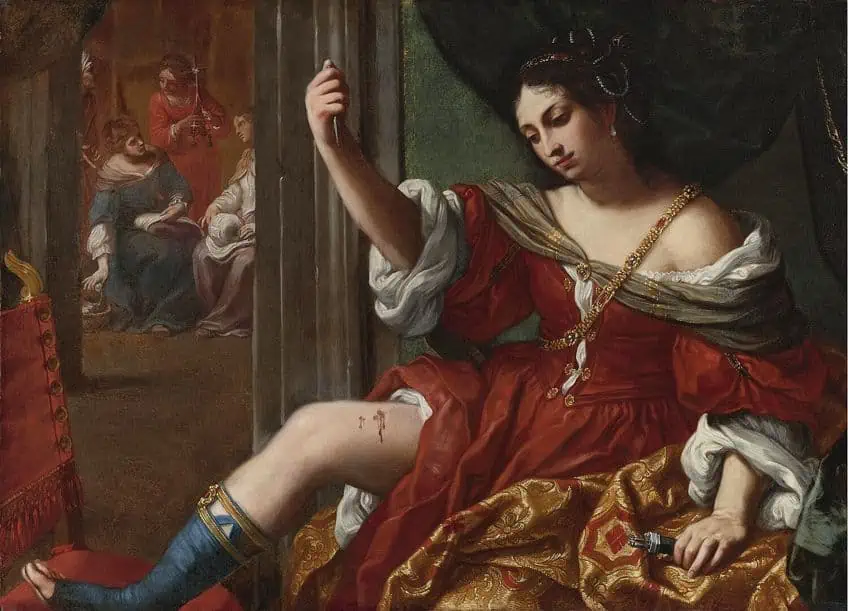
That concludes our list of famous Renaissance paintings. Art from the Renaissance differed from previous eras in that artists began to experiment with the realistic portrayal of people as well as incorporating linear perspective into their works. Many of the famous Renaissance artworks mentioned above embody these advancements and helped steer the course of art history. The influence of these Renaissance artists’ paintings was not only significant in their own time as it can still be felt today.
Take a look at our Renaissance paintings webstory here!
Frequently Asked Questions
What Characterizes Famous Renaissance Paintings?
During the Renaissance period, painting began to evolve in many ways. The inclusion of linear perspective became a priority, in addition to the realistic rendering of human figures. Artists also began to study human anatomy in order to accurately portray our figures. Lighting became a significant focus and landscapes were also portrayed realistically.
What Are a Few of the Most Famous Renaissance Artworks?
The Renaissance era witnessed an explosion in creativity and innovation. Therefore, there are almost endless examples of noteworthy paintings that were produced during this period. Some of these include The Last Judgment (1541) by the highly-revered artist, Michelangelo, the iconic The Last Supper (1498) painting by the Master, Leonardo Da Vinci, Sistine Madonna (1512) by Raphael, Portrait of a Noblewoman (1580) by Lavinia Fontana, an important early female painter, and The Birth of Venus (1486) by Sandro Botticelli, among countless others.
Jordan Anthony is a Cape Town-based film photographer, curator, and arts writer. She holds a Bachelor of Art in Fine Arts from the University of the Witwatersrand, Johannesburg, where she explored themes like healing, identity, dreams, and intuitive creation in her Contemporary art practice. Jordan has collaborated with various local art institutions, including the KZNSA Gallery in Durban, the Turbine Art Fair, and the Wits Art Museum. Her photography focuses on abstract color manipulations, portraiture, candid shots, and urban landscapes. She’s intrigued by philosophy, memory, and esotericism, drawing inspiration from Surrealism, Fluxus, and ancient civilizations, as well as childhood influences and found objects. Jordan is working for artfilemagazine since 2022 and writes blog posts about art history and photography.
Learn more about Jordan Anthony and about us.
Cite this Article
Jordan, Anthony, “Famous Renaissance Paintings – Explore This Influential Art Era.” artfilemagazine – Your Online Art Source. November 2, 2023. URL: https://artfilemagazine.com/famous-renaissance-paintings/
Anthony, J. (2023, 2 November). Famous Renaissance Paintings – Explore This Influential Art Era. artfilemagazine – Your Online Art Source. https://artfilemagazine.com/famous-renaissance-paintings/
Anthony, Jordan. “Famous Renaissance Paintings – Explore This Influential Art Era.” artfilemagazine – Your Online Art Source, November 2, 2023. https://artfilemagazine.com/famous-renaissance-paintings/.


